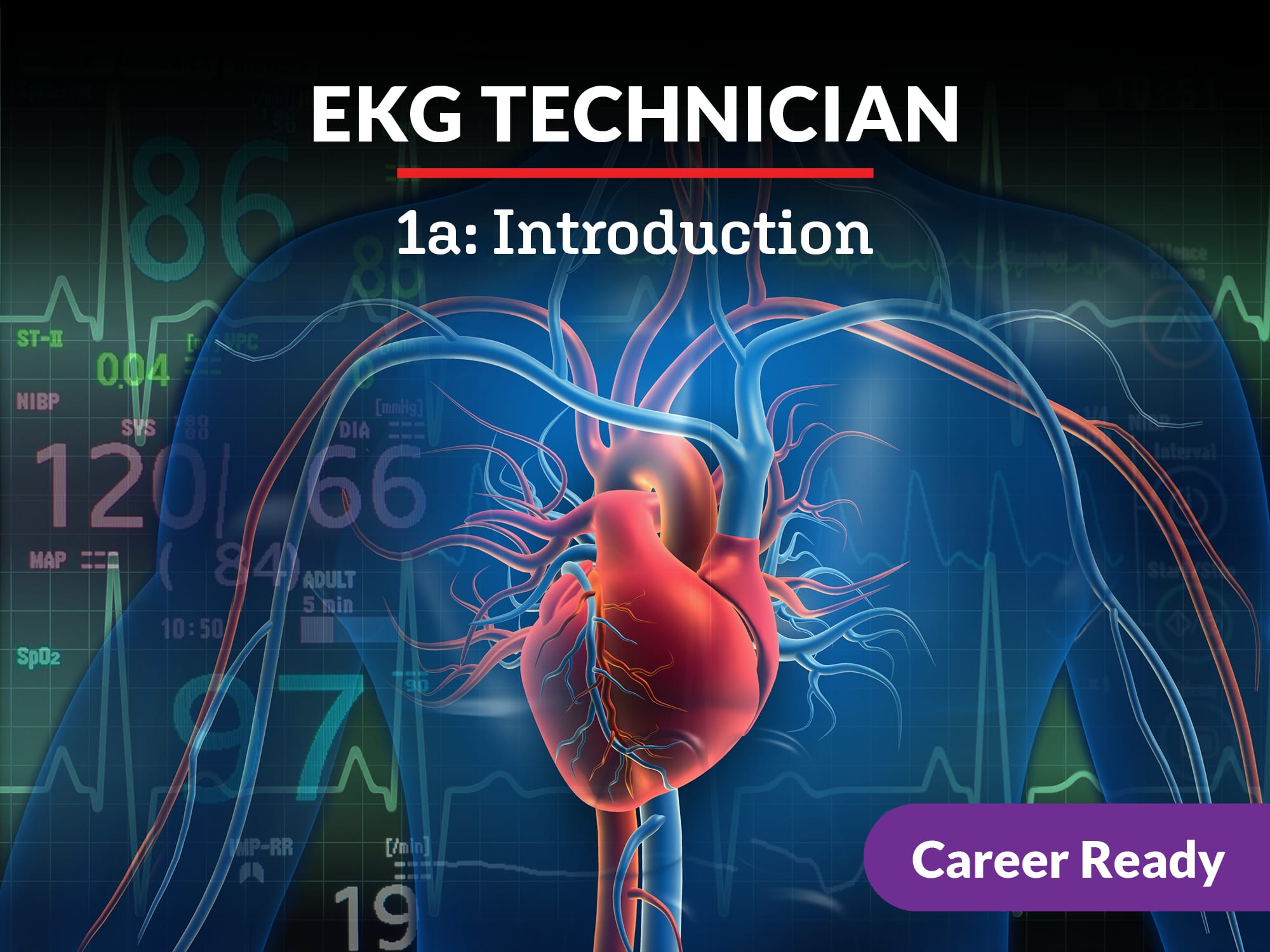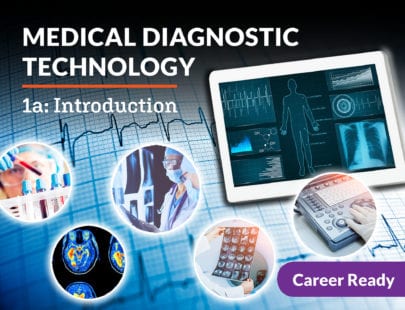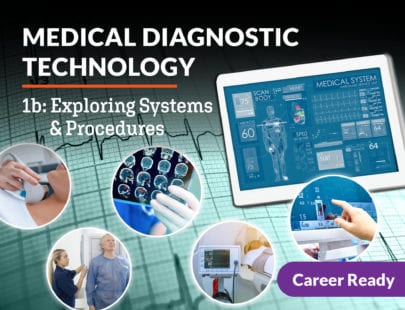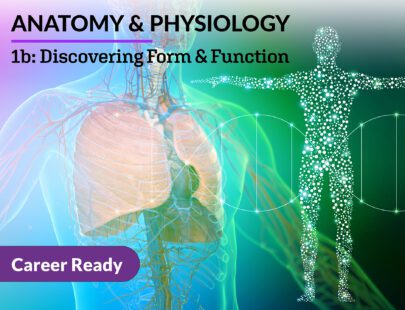
EKG Technician 1a: Introduction
Our hearts are essential to our survival. And EKG technicians play an important role in administering tests and evaluating data given by the electrocardiogram (EKG) to treat patients effectively. Explore the cardiovascular system and its anatomy, and its role in our body, health, and lives. If you’re a people person and want to work in healthcare, build the knowledge and skill base to prepare you for a cardiovascular career.
Units at a Glance
Unit 1: Cardiovascular Health Awareness
Why is cardiovascular health such a hot topic? How important is it, anyway? Using reputable sources to analyze data, we’ll see the staggering statistics that answer these questions. We’ll also discover what actions are taken based on this data and compare preventative measures for diagnosis and treatment. Using this information, we’ll get “heart smart” and learn about the major steps that have been taken to improve cardiovascular health awareness.
What will you learn in this unit?
- Locate and recognize credible sources when researching topics for cause and effect
- Identify the incidence of heart disease and disorders as well as the number of associated deaths using CDC data
- Describe the negative effects of complications on the cardiovascular and pulmonary systems
- Compare the cost of common preventative measures with common diagnostic procedures to evaluate the effect of each on healthcare costs
- Describe the Healthy People Initiative, including the goals, objectives, baselines, and strategies used to implement change
Unit 2: Preparing for Cardiovascular Careers
Choosing a career can be a stressful and overwhelming decision! One of the best ways to approach this task is to learn about the careers available as well as the skills and traits required to be successful in that field. With this newfound knowledge, you’ll be ready to face this type of decision head-on. Get excited as we build the knowledge and skill base to prepare you for a cardiovascular career!
What will you learn in this unit?
- Identify careers involving the cardiovascular and pulmonary systems
- Consider the educational and certification requirements for careers involving the cardiovascular and pulmonary systems
- Explain the importance of scope of practice and practice standards as they relate to the various careers in the cardiovascular and pulmonary sciences
- Analyze labor market data to determine career growth opportunities
- Describe career readiness and the skills needed to enter the workforce
- Write a cover letter, prepare a resume, and complete a job application
Unit 3: Legal, Ethical, and Safety Considerations
Coming into a healthcare facility can be a scary experience for anyone, but knowing healthcare professionals play a role in protecting the patient helps ease some of that anxiety. As we explore the legal, ethical, and safety measures used in health occupations, we’ll learn about the steps taken to create a safe environment in which the patient’s rights are protected at all times. We’ll also examine the role of HIPAA legislation and how other regulations impact the patient care process.
What will you learn in this unit?
- Describe the legal and ethical responsibilities of a healthcare professional
- Identify safety hazards and ways to reduce or eliminate danger from them
- Know the Joint Commission National Patient Safety Goals
- Understand the importance of the Health Insurance Portability and Accountability Act (HIPAA)
- Explain the importance of using legal requirements like consent forms to protect patient rights
Unit 4: An In-Depth Look at the Cardiovascular System
At this point, we’ve explored major parts of the cardiovascular system such as the heart, arteries, veins, and capillaries, but how do all of these things really work? As we zoom in a little closer, we’ll identify the functions of each component all the way down to the cellular level! With this new knowledge, we’ll analyze what makes a heart beat and how this impacts blood flow and other functions within the system. We may have scratched the surface before, but now, we’re ready to take an in-depth look at the cardiovascular system!
What will you learn in this unit?
- Identify and describe the parts of the cardiovascular system
- Name and detail the parts of the autonomic system
- Describe blood flow through the cardiovascular system
- Discuss the parts of the electrical conduction system and how it relates to an EKG waveform
- Understand the measurements used for the cardiovascular system and how they relate to cardiovascular function
Unit 5: Analyze and Identify Pathophysiology
Recognizing when something is wrong with a patient is a critical skill for any healthcare worker to have. When dealing with the cardiac, circulatory, pulmonary, and autonomic nervous systems, signs and symptoms help alert healthcare professionals to potential problems so that they can respond appropriately. As we explore different diseases and disorders of these systems, we’ll identify signs and symptoms so that we can respond to medical situations appropriately.
What will you learn in this unit?
- Identify normal as well as abnormal heart and breath sounds
- Analyze the vital signs, heart sounds, and breath sounds identified with pathophysiology
- Describe the signs and symptoms of poor perfusion and low cardiac output
- Recognize common pathophysiology related to the cardiovascular, pulmonary, and autonomic nervous systems as well as describe common interventions for them
- Discuss the differences between treating cardiac and pulmonary complications in a physician’s office and an emergency department
Unit 6: Lead Placement and Why It Matters
We know about the importance of the waveform produced by an EKG, but how do we get a recording of it? Isn’t the recording the same no matter where we record it from? A critical function of an EKG technician is placing the electrodes and the leads so that the test accurately reflects what the heart is doing. Although this task may seem simple, there’s a lot more to it than you might think. Let’s break down the lead placement process and gain an understanding of exactly why it matters so much.
What will you learn in this unit?
- Describe the differences between standard limb leads, augmented limb leads, and precordial leads
- Explain Einthoven’s triangle, the hexaxial reference system, and their importance in ECG testing
- Identify proper placement for three-, five-, 12-, and 15-lead EKGs
- Analyze special situations in patients and describe ways to adjust when performing EKGs
- Verify lead placement when performing an EKG
Unit 7: Types of EKG Testing and Documentation Processes
When we think of an EKG, we picture the electrodes connected to the patient’s chest, but there’s more to the world of EKG than a few wires! The principles and equipment used in performing an EKG allow healthcare providers to expand testing on patients to get a better understanding of what’s really going on. As part of this process, EKG techs document everything along the way. Have you ever been a patient and wondered what the healthcare professional was writing or typing about you? Here’s your chance to find out!
What will you learn in this unit?
- Describe 3-, 5-, 12-, and 15-lead EKGs along with patients’ expectations before, during, and after testing
- Explain Holter monitors before, during, and after testing
- Outline stress testing before, during, and after testing
- Understand telemetry before, during, and after testing
- Analyze the importance of patient documentation during the types of EKG testing
Unit 8: Exploring EKG Equipment
An EKG machine is like any other EKG machine, right? Not quite! As we explore the history of the development of the EKG, we’ll see how the techniques and devices used for testing have changed over time. As part of our exploration, we’ll investigate the skills and knowledge needed to maintain and troubleshoot this equipment. We’ll also see how the machine’s settings influence its performance during testing. Gear up for a glimpse of the technical side of EKGs!
What will you learn in this unit?
- Recount the history of the EKG machine and identify advances in the technology related to its use
- Explain the similarities and differences between pieces of EKG equipment that use different channels
- Describe the appropriate settings for the EKG machine
- Relay steps for maintaining and cleaning an EKG machine
- Troubleshoot problems when using EKG equipment
Required Materials
Physical
- Tape or stickers (blue masking tape recommended)
Software
- Word processor software
- Slide presentation software
- Spreadsheet software
- Video camera or audio recorder
- Camera
- Image creation software
Other
- “Scene” partner, dummy, or some proxy for a human (could require large sheets of paper and markers)
Optional
- Audio recording device
- Marker or pen



